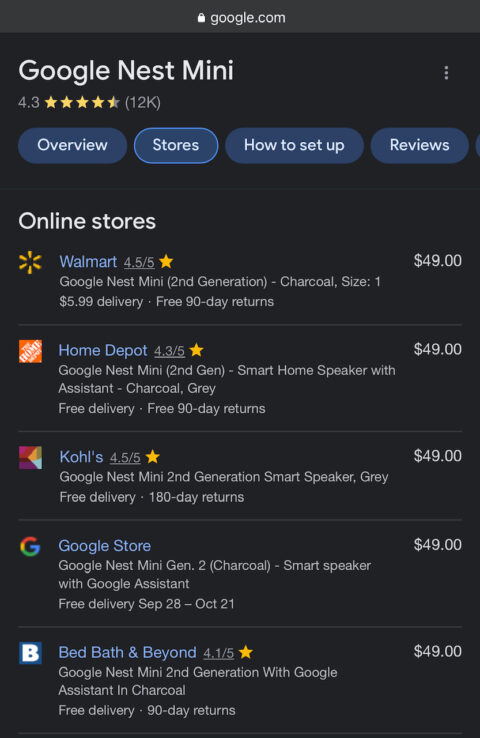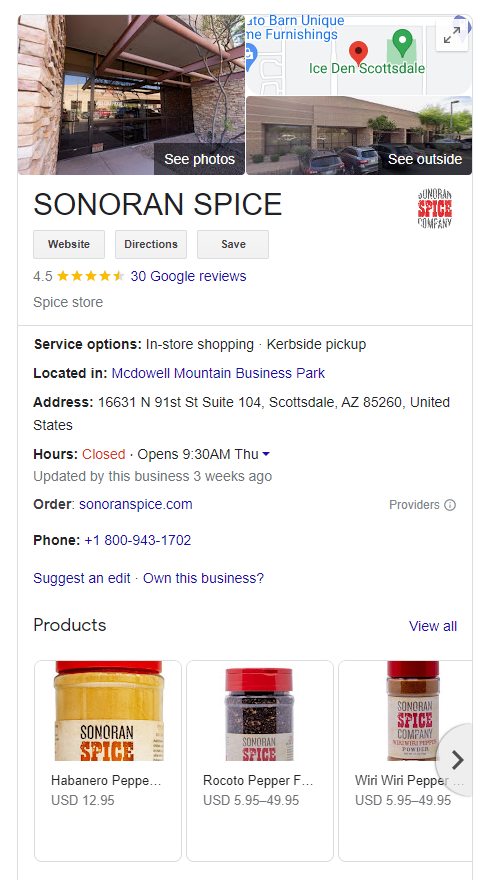8 Must-Have Ecommerce Rich Snippets To Stand Out In Search

Search results have come a long way. A standard organic search result before Google introduced SERP features returned the title tag, meta description, and URL.
Fortunately, you don’t need to limit your ecommerce store’s organic search performance to this.
Stay one step ahead of your competitors with the implementation of structured data. It allows you to feature your product in search results with product details, pricing, availability, and even shipping times.
How do rich results apply to e-commerce?
Google Rich Results are snippets of content displayed on SERPs (Search Engine Results Pages). Rich results can be either a snippet of text or an image with a description.
Search engines can only display rich snippets of structured data on your website.
Structured data uses schema markup, a lingua franca among search engines, to help them better understand your page, so they can display more accurate information in a way that is attractive to shoppers in search results.
With appropriate structured data, merchants will be eligible to display products for sale directly from search results.
Ecommerce rich snippets provide shoppers with additional information about the products you offer directly from the search results pages. This includes price, availability, review summary, description, and more.
Ecommerce rich results don’t end at the product page.
There are basic pieces of schema markup that you can apply to other pages on your site.
like Google statesAnd
Remember, shoppers may be at different stages of their shopping journey and are looking for more than just product pages.
This article will explore the most important structured data to apply to your ecommerce store.
What are the best practices for ecommerce schema markup
Structured data will not affect your SEO directly.
However, it will provide you with the best opportunity for rich snippets, which can help improve click-through rates and conversions, and ultimately, these can have a flow impact on your SEO.
Rich snippets will only appear in search results at Google’s discretion. To do this, Google relies on the optimal inline structured data.
Depending on the e-commerce platform you are using, structured data markup applications are available to help you do this, such as JSON-LD for SEO Shopify app.
Otherwise, you can implement structured data yourself, by following the different guides for your platform.
Best practices for implementing structured data are:
- Include only relevant structured data.
- Focus on the core meaning of the product.
- Use unique identifiers for products.
- Avoid using conflicting or redundant information. Some review apps implement their own review schema markup, and this can confuse search engines.
8 rich snippets for e-commerce
1. Product extracts
Detailed product information to attract clicks
As an e-commerce store, products are your bread and butter.
When users are looking for a specific product, it is helpful to have additional information on display to help them make a more informed decision.
Depending on your industry and product offering, Google may choose to display certain features such as color, size, material, etc., depending on the product markup that it can pull from your page.
These are taken on a case-by-case basis, vary by location, and may not always be shown.
 Image courtesy of Google, September 2022
Image courtesy of Google, September 2022To qualify for rich results product, make sure you have the extension Required product coding To quality for product rich results.
Here is a rundown of the top ecommerce product markup to drive more clicks and, ultimately, more sales:
- compilation Average rating for this product.
- Brand – The trademark associated with the offered product.
- Describe Detailed description of the offered product.
- picture – Full description of the image body https://schema.org/ImageObject or product image URL
- GTIN number – A global trade item number is a unique product identifier such as gtin8 / gtin13 / gtin 14 / mpn / isbn. Google recommends You are using the most specific GTIN that applies to your product for the most accurate representation of the product.
- Noun – product name.
- Offers – Used for product variants where the price range will be displayed.
2. Reviews Extracts
Show off your glowing yellow stars
Ecommerce stores the only review markup they need to perform on their product pages is aggregateRating.
While this review markup technically falls under “product markup,” it’s important to highlight it. Review markup for a product page can make or break a product listing in SERPs.
those yellow stars you see in product search results; This is a bulk rich excerpt.
To qualify for richRating rich snippets, you’ll need direct product reviews on your product page, based on the average of those ratings.
More reasons to collect glowing product reviews from customers!
 Screenshot from Google, September 2022
Screenshot from Google, September 2022Attempting to manipulate comment markup with fake comments or other spammy comment markup may be harmful to your store. This behavior is strictly against Google policies.
3. View excerpts
Make your irresistible offer stand out
Display markup provides search engines with up-to-date price and availability information.
These appear below your meta description and can be very helpful to customers already at the buying decision stage:
- availability – Displays whether the product is in stock, out of stock, pre-ordered, etc.
- Price – This should be a specific price, not a range. Marking up the offer will make you eligible for a price drop offer rich snippets (if available in your country).
- currency price – The applicable currency in which your product is sold.
- priceValidUntil (in ISO 8601 date format) – the date after which the price is no longer available.
- SKU – Your unique SKU ID for the product.
- url – The URL of the product page on your website.
- Item condition Displays whether the product is being sold as new or used.
4. Breadcrumb snippets
Help search engines understand your page hierarchy and improve user navigation
Think of breadcrumbs as a series of clicks that are left behind when you go to a page on your website. They are displayed in the search results as follows:
 Screenshot from Google, September 2022
Screenshot from Google, September 2022Navigation menu Coding helps crawling bots understand the hierarchy of pages and display a more accurate path in search results. It is helpful for customers to understand the logical categorization of your products and to navigate back and forth between product and category pages.
BreadcrumbList markup must include the following to be eligible for rendering:
- put.
- purpose.
- ID.
- Noun.
5. Organizing extracts
Gain credibility and trust for your brand
A search query for your brand will generally (if SEO is effective) show your store’s homepage in the first position of the SERP.
This may not be the case if you have stock competing for your branded keywords. You can help your homepage stand out from other results and instantly gain trust and credibility with the help of homepage markup.
- website – URL, target, query input is required.
- organisation – desired name, url, description, logo, image, same title, title.
Contact information such as a phone number is also useful here, allowing users to click the link from their mobile device and contact you directly from the results page.
6. FAQ snippets
Take up more search engine space
Category pages are often the strongest performing pages for ecommerce pages because they tend to attract broader keywords and higher search volume.
While there aren’t as many opportunities to get rich results for a category page compared to product pages, you can still take advantage of two key tags to take up white space in the SERP:
- Bread crumbs.
- Instructions.
 Screenshot of search [best CRM software]Google, September 2022
Screenshot of search [best CRM software]Google, September 2022Google recently clarified that FAQ markup is allowed for content other than FAQs.
By using the FAQ on the page, you can qualify for rich results.
When the FAQ is displayed as a snippet, your category page’s search result will take up more space and stand out.
You also have the opportunity to answer some lingering questions potential customers might have about your product offerings.
7. Shipping scraps
Set expectations to help customers buy now
Shipping markup is underutilized and is a great way to make your product listing stand out.
When a user can view expected shipping costs and times from within the search results, it can help them make a faster and more informed purchasing decision. This also sets realistic expectations about charging times and creates a better user experience.
 Screenshot of search [google mini nest]Google, September 2022
Screenshot of search [google mini nest]Google, September 2022OfferShippingDetails It represents information about shipping destinations. The most useful markup displayed for ecommerce stores is:
- Shipping Rate – The total cost a user can expect to pay to their destination for their order.
- Delivery time Displays the time between the time a customer orders and receives an item.
8. Website excerpts
Make your mark on the map
If your e-commerce store also has a physical location, inventory location data can be powerful to help Google show you the availability of your inventory for “near me” product queries.
A Google Business Profile listing is required to display rich site information.
This can then display a beautifully detailed view of your store and a summary of your offerings in the search results.
 Screenshot from Google, September 2022
Screenshot from Google, September 2022How to validate structured data
To help improve the accuracy of your rich snippets when viewed, provide Google with accurate structured data. In contrast, they are more likely not to make a mistake when extracting it automatically.
There are many ways to validate structured data and check for errors, including using checker chart.
The simplest way is to use Rich results testing tool.
To test whether product markup is being shown, check the page with the URL Inspection tool in Google Search Console to make sure it’s indexed.
There is a lot of untapped potential in achieving rich snippets for ecommerce.
By implementing proper schema markup, you will give your store the best chance of earning rich results and standing out from the competition.
More resources:
- The Local SEO Blueprint: A Complete Guide to Local Coding and Rich Results
- How to Optimize Google Featured Snippets: A 12 Step Guide
- Ecommerce Marketing: The Ultimate Guide
Featured image: Roman Samborski/Shutterstock



